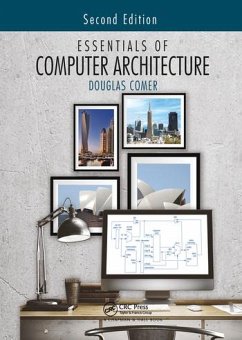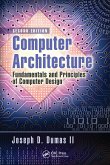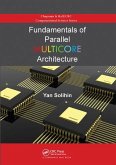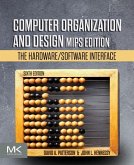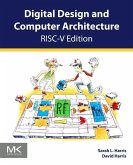Douglas Comer
Essentials of Computer Architecture
Douglas Comer
Essentials of Computer Architecture
- Broschiertes Buch
- Merkliste
- Auf die Merkliste
- Bewerten Bewerten
- Teilen
- Produkt teilen
- Produkterinnerung
- Produkterinnerung
This easy to read textbook provides an introduction to computer architecture, while focusing on the essential aspects of hardware that programmers need to know. The topics are explained from a programmerâ s point of view, and the text emphasizes consequences for programmers. Divided in five parts, the book covers the basics of digital logic, gate
Andere Kunden interessierten sich auch für
![Computer Systems Architecture Computer Systems Architecture]() Aharon YadinComputer Systems Architecture48,99 €
Aharon YadinComputer Systems Architecture48,99 €![Computer Architecture Computer Architecture]() Joseph D. Dumas IIComputer Architecture67,99 €
Joseph D. Dumas IIComputer Architecture67,99 €![Fundamentals of Parallel Multicore Architecture Fundamentals of Parallel Multicore Architecture]() Yan SolihinFundamentals of Parallel Multicore Architecture51,99 €
Yan SolihinFundamentals of Parallel Multicore Architecture51,99 €![Computer Architecture Computer Architecture]() Charles FoxComputer Architecture33,99 €
Charles FoxComputer Architecture33,99 €![Computer Organization and Design MIPS Edition Computer Organization and Design MIPS Edition]() David A. Patterson (Pardee Professor of Computer Science, Emeritus,Computer Organization and Design MIPS Edition108,99 €
David A. Patterson (Pardee Professor of Computer Science, Emeritus,Computer Organization and Design MIPS Edition108,99 €![Digital Design and Computer Architecture, RISC-V Edition Digital Design and Computer Architecture, RISC-V Edition]() Sarah Harris (Harvey Mudd Colle Assistant Professor of EngineeringDigital Design and Computer Architecture, RISC-V Edition78,99 €
Sarah Harris (Harvey Mudd Colle Assistant Professor of EngineeringDigital Design and Computer Architecture, RISC-V Edition78,99 €![Programming Massively Parallel Processors Programming Massively Parallel Processors]() Wen-mei W. Hwu (MulticoreWare CTO and professor specializing in coProgramming Massively Parallel Processors95,99 €
Wen-mei W. Hwu (MulticoreWare CTO and professor specializing in coProgramming Massively Parallel Processors95,99 €-
-
-
This easy to read textbook provides an introduction to computer architecture, while focusing on the essential aspects of hardware that programmers need to know. The topics are explained from a programmerâ s point of view, and the text emphasizes consequences for programmers. Divided in five parts, the book covers the basics of digital logic, gate
Produktdetails
- Produktdetails
- Verlag: Taylor & Francis Ltd
- 2 ed
- Seitenzahl: 536
- Erscheinungstermin: 30. Juni 2020
- Englisch
- Abmessung: 246mm x 189mm x 29mm
- Gewicht: 1020g
- ISBN-13: 9780367573959
- ISBN-10: 0367573954
- Artikelnr.: 61605266
- Herstellerkennzeichnung
- Libri GmbH
- Europaallee 1
- 36244 Bad Hersfeld
- gpsr@libri.de
- Verlag: Taylor & Francis Ltd
- 2 ed
- Seitenzahl: 536
- Erscheinungstermin: 30. Juni 2020
- Englisch
- Abmessung: 246mm x 189mm x 29mm
- Gewicht: 1020g
- ISBN-13: 9780367573959
- ISBN-10: 0367573954
- Artikelnr.: 61605266
- Herstellerkennzeichnung
- Libri GmbH
- Europaallee 1
- 36244 Bad Hersfeld
- gpsr@libri.de
Douglas Comer is a Distinguished Professor of Computer Science at Purdue University. He is an internationally recognized expert on computer networking and the TCP/IP protocols. He has been working with TCP/IP and the Internet since the late 1970s. Comer established his reputation as a principal investigator on several early Internet research projects. He served as chairman of the CSNET technical committee, chairman of the DARPA Distributed Systems Architecture Board, and was a member of the Internet Activities Board (the group of researchers who built the Internet). Comer has created courses on computer networks, the Internet, TCP/IP protocols, and operating systems for a variety of audiences, including in-depth courses for engineers and less technical courses for others; he continues to teach at various industries and networking conferences around the world. In addition, Comer consults for private industry on the design of networks and networking equipment. Professor Comer is well-known for his series of ground breaking textbooks on computer networks, the Internet, computer operating systems, and computer architecture. His books have been translated into sixteen languages, and are widely used in both industry and academia. His three-volume series Internetworking With TCP/IP is often cited as an authoritative reference for the Internet protocols. More significantly, Comer's texts have been used by fifteen of the top sixteen Computer Science Departments listed in the U.S. News and World Report ranking.
Preface. Introduction and Overview. Part 1. Basics. Fundamentals of Digital
Logic. Data and Program Representation. Part II. Processors. The Variety Of
Processors And Computational Engines. Processor Types and Instruction Sets.
Data Paths and Instruction Execution. Operand Addressing and Instruction
Representation. CPUs: Microcode, Protection, And Processor Modes. Assembly
Languages And Programming Paradigm. Part 3. Memories. Memory and Storage.
Physical Memory And Physical Addressing. Caches and Caching. Virtual Memory
Technologies And Virtual Addressing. Part 4 I/O. Input /Output Concepts And
Terminology. Buses and Bus Architecture. Programmed And Interrupt-Driven
I/O. A Programmer's View Of Devices, I/O, And Buffering. Part 5 Advanced
Topics. Parallelism. Pipelining. Power and Energy. Assessing Performance.
Architecture Examples and Hierarchy. Hardware Modularity. Appendix 1. Lab
Exercises For A Computer Architecture Course. Appendix 2. Rules For Boolean
Algebra Simplification. Appendix 3. A Quick Introduction To x86 Assembly
Language. Appendix 4. ARM Register Definitions And Calling Sequence
Logic. Data and Program Representation. Part II. Processors. The Variety Of
Processors And Computational Engines. Processor Types and Instruction Sets.
Data Paths and Instruction Execution. Operand Addressing and Instruction
Representation. CPUs: Microcode, Protection, And Processor Modes. Assembly
Languages And Programming Paradigm. Part 3. Memories. Memory and Storage.
Physical Memory And Physical Addressing. Caches and Caching. Virtual Memory
Technologies And Virtual Addressing. Part 4 I/O. Input /Output Concepts And
Terminology. Buses and Bus Architecture. Programmed And Interrupt-Driven
I/O. A Programmer's View Of Devices, I/O, And Buffering. Part 5 Advanced
Topics. Parallelism. Pipelining. Power and Energy. Assessing Performance.
Architecture Examples and Hierarchy. Hardware Modularity. Appendix 1. Lab
Exercises For A Computer Architecture Course. Appendix 2. Rules For Boolean
Algebra Simplification. Appendix 3. A Quick Introduction To x86 Assembly
Language. Appendix 4. ARM Register Definitions And Calling Sequence
Preface. Introduction and Overview. Part 1. Basics. Fundamentals of Digital
Logic. Data and Program Representation. Part II. Processors. The Variety Of
Processors And Computational Engines. Processor Types and Instruction Sets.
Data Paths and Instruction Execution. Operand Addressing and Instruction
Representation. CPUs: Microcode, Protection, And Processor Modes. Assembly
Languages And Programming Paradigm. Part 3. Memories. Memory and Storage.
Physical Memory And Physical Addressing. Caches and Caching. Virtual Memory
Technologies And Virtual Addressing. Part 4 I/O. Input /Output Concepts And
Terminology. Buses and Bus Architecture. Programmed And Interrupt-Driven
I/O. A Programmer's View Of Devices, I/O, And Buffering. Part 5 Advanced
Topics. Parallelism. Pipelining. Power and Energy. Assessing Performance.
Architecture Examples and Hierarchy. Hardware Modularity. Appendix 1. Lab
Exercises For A Computer Architecture Course. Appendix 2. Rules For Boolean
Algebra Simplification. Appendix 3. A Quick Introduction To x86 Assembly
Language. Appendix 4. ARM Register Definitions And Calling Sequence
Logic. Data and Program Representation. Part II. Processors. The Variety Of
Processors And Computational Engines. Processor Types and Instruction Sets.
Data Paths and Instruction Execution. Operand Addressing and Instruction
Representation. CPUs: Microcode, Protection, And Processor Modes. Assembly
Languages And Programming Paradigm. Part 3. Memories. Memory and Storage.
Physical Memory And Physical Addressing. Caches and Caching. Virtual Memory
Technologies And Virtual Addressing. Part 4 I/O. Input /Output Concepts And
Terminology. Buses and Bus Architecture. Programmed And Interrupt-Driven
I/O. A Programmer's View Of Devices, I/O, And Buffering. Part 5 Advanced
Topics. Parallelism. Pipelining. Power and Energy. Assessing Performance.
Architecture Examples and Hierarchy. Hardware Modularity. Appendix 1. Lab
Exercises For A Computer Architecture Course. Appendix 2. Rules For Boolean
Algebra Simplification. Appendix 3. A Quick Introduction To x86 Assembly
Language. Appendix 4. ARM Register Definitions And Calling Sequence

